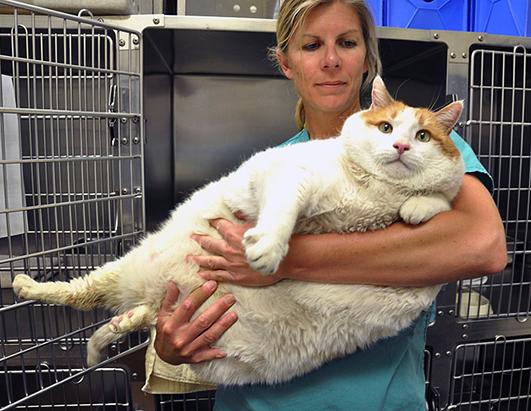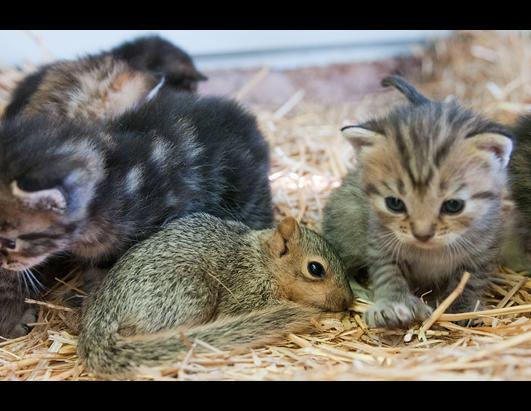The true horrors of pet food revealed: Prepare to be shocked by what goes into dog food and cat food
If you check the labels on grocery store foods, you've probably already begun to see that the list of ingredients doesn't always tell the whole truth about what's in your food. The same goes for your pets' food. Behind innocent-sounding words like "meat byproducts" and "meat meal" are horrific manufacturing practices that would turn your stomach. The nutritional considerations of pet foods go beyond the sources of meat in them. Pet food manufacturers add dangerous preservatives and vitamin fortifications that actually make your pets' food lesshealthy.
What mysterious "meatbyproducts" really are
Let's start with what usually appears as theproteinsource and the primary ingredient inpet food: Meat byproducts or meat meal. Both are euphemisms for the parts ofanimalsthat wouldn't be considered meat by any smart consumer. The well-known phrase "meat byproducts" is a misnomer since these byproducts contain little, if any, meat. These are the parts of the animal left over after the meat has been stripped away from thebone. "Chicken by-products include head, feet, entrails,lungs, spleen, kidneys, brain,liver, stomach, bones, blood,intestines, and any other part of the carcass not fit for humanconsumption," writes Henry Pasternak inHealing Animals with Nature's Cures.Meat meal can contain the boiled down flesh of animals we would find unacceptable for consumption. This can include zoo animals, road kill, and 4-D (dead, diseased, disabled, dying)
livestock. Most shockingly, this also can include
dogsand cats. That's right,
yourpetscould be cannibals.
Fast Food Nationauthor Eric Schlosser writes, "Although leading American manufacturers promise never to put rendered pets into their pet
food, it is still legal to do so. A Canadian company, Sanimal Inc., was putting 40,000 pounds of dead dogs and dead cats into its dog and
cat foodevery week, until discontinuing the practice in June 2001. "This food is healthy and good," said the company's vice president of procurement, responding to critics, ''but some people don't like to see meat meal that contains any pets."
How roadkill ends up in Fido's food bowl
The process that turns these animals and animal parts into pet food is also disgusting. After all, it takes a lot to turn roadkill into something owners feel good about pouring into their pets' bowls. Ann M. Martin describes the process inFood Pets Die For: "At the rendering plant a machine slowly grinds the entire mess in huge vats. Then this product is cooked at temperatures between 220 degrees Fahrenheit and 270 degrees Fahrenheit for 20 minutes to one hour. The mixture is centrifuged (spun at a high speed) and the grease (or tallow) rises to the top and it is removed from the mixture. The grease becomes the source of animal fat in most petfoods. Oftentimes, when you open a standard can ofdog food, you will see a top layer offat. The centrifuged product is the source of that fat, which is meant to entice a hungrydogor cat. After the grease is removed in the rendering process, the remaining material is dried. Meat meal, and meat and bone meal are the end product of this process. This dried material is usually found in dry pet food."
Chemical dangers lurk in commercial pet food
Rendering practices aren't just gross; they're also dangerous for your pets. Thechemicalsused to euthanize zoo animals, dogs and cats can survive thecookingprocess, which means these chemicals end up in pet food, and ultimately, in your pet. Martin writes, "Euthanized cats and dogs often end up in rendering vats along with other questionable material to make meat meal, and meat and bone meal. This can be problematic becausesodiumpentobarbital can withstand the heat from rendering. For years, someveterinariansand animal advocates have known about the potentialdangerof sodium pentobarbital residue in commercial pet food, yet the danger has not been alleviated." In short, that meansthe poisons designed to kill pets are the same ones being fed to them.Now that you know pet
food manufacturerswill seemingly go to any length to fill their foods with the cheapest sources of protein they can find, you probably won't be surprised to find out that the other
ingredientsin pet foods aren't much better. Cheap grain fillers, cellulose to bulk up the food, preservatives and poorly monitored vitamin and mineral supplements round out the recipe. In
Healing Pets with Nature's Miracle Cures, Henry Pasternak writes, "Remember, pet foods are primarily processed, grain-based diets. These foods are 'fortified' with synthetic B vitamins, which can cause a subclinical B vitamin
deficiency." Martin mentions in
Food Pets Die Forthat one bag of dog food was overloaded with so much
zincthat she had to take her dog to the vet because he became ill. She took the bag of food to an independent lab to verify that the zinc content of the food was 20 times the recommended daily allowance for dogs.
Preservatives in dog and cat foods keep the foods seemingly fresh for long periods of time: "Unfortunately, harmful chemical preservatives and other artificial additives are the norm in most pet foods. Some are intentionally added by the manufacturer, while others come from the herbicides,
insecticides, and pesticides used by
farmersto boost crop yields," Pasternak writes. While some pet
food companieshave decided to use less harmful preservatives and
naturalpreservatives, most pet food
companiesdon't find these ingredients to be cost effective.
So what should you do with this
information? Many pet owners are discovering there are more natural alternatives to commercial pet food. Natural
healthfood stores usually stock a few varieties of organic or all-natural pet foods. There are other owners who go even further and prepare their pets' foods from real, whole ingredients. Though this might not be for everyone, some owners say it's worth the peace of mind, and it helps them feel closer to their animal companions. Be aware though, that once your pet finds out what real,
whole foodstake like, they may not want to go back: "I used to feed my cat canned or dry pet food, but now I prepare her food from fresh ingredients. She thrives on raw meat," writes Debra Lynn Dadd in
Home Safe Home. "She will eat canned or dry food if it is a natural brand, but if I give her pet food from the supermarket, she paws around it like she's trying to cover up something in her litter box."
The experts speak on pet food processing:
Most veterinarians acquire their only knowledge on pet
nutritionin elective classes in veterinary school. These classes may only last a few weeks and are often taught by representatives from pet food companies. Hill's, lams, and Purina are the largest contributors for these courses. In addition, pet food companies even donate food to the vet students for their own companion animals. This practice has become so widespread among pet food companies that the veterinary school at Colorado State University made this an agenda item for an Executive Committee meeting in 2000. "Discussion was held on how to handle dealing with pet food companies and their donations of pet food to the university," according to the Executive
Food Pets Die For by Ann N Martin, page 21
Dry food has its advantages. In fact, the dry pet food you buy in the supermarket is manufactured for your convenience as much as Fifi's and Fluffy's health. It's the nibble-at -will, no-can-opening, no-greasy-spoon, no-smelly-bowl, no-budget-busting pet food. It has lower levels of fat than canned meat because the fat seeps through the
paperbags (you don't want that greasy bag on your
carupholstery or in your kitchen cabinet). Fifi and Fluffy get to eat more for your money, thus getting pleasantly full tummies, while less protein, fat and digestibility keep their figures from becoming unbecomingly porcine.
Everyday Health Tips by Prevention Magazine, page 346
Fats are necessary for good health and disease
prevention. Here again, fats should be raw or unrefined—not processed. Meat, fish,
eggs, or milk in their natural states are the best sources of fat. The pet
food industryprepares some pet foods with high levels of
omega-3 fatty acidsthat are claimed to be effective for treating various inflammatory diseases. However, omega-3
fatty acidsare quite sensitive to heat and are destroyed and easily become rancid during processing. Cod liver
oilcan be added to pet foods. It is a good source of
omega-3fatty acids as well as
vitamin A. Proteins
Healing Pets With Nature's Miracle Cures By Henry Pasternak DVM CVA, page 77
They don't need "special" diets. Your typical pet will do nicely on typical pet food. "There are a lot of marketing gimmicks in the pet food
industrythat aren't necessarily in the best interest of the dog," says Dr. Donoghue. It's not always a good idea, for example, to reduce protein in the
dietof a healthy old dog.
Everyday Health Tips by Prevention Magazine, page 348
Sodium Pentobarbital:
As I discuss elsewhere, euthanized cats and dogs often end up in rendering vats along with other questionable material to make meat meal, and meat and bone meal. This can be problematic because sodium pentobarbital can withstand the heat from rendering. For years, some veterinarians and animal advocates have known about the potential danger of sodium pentobarbital residue in commercial pet food, yet the danger has not been alleviated. The "Report of the American Veterinary Medical Association (AVMA) Panel on Euthanasia," states, "In euthanasia of animals intended for human or animal food, chemical agents that result in tissue residue cannot be used."
Food Pets Die For by Ann N Martin, page 57
Another staple of the Tenderer's diet, in addition to farm animals, is euthanized pets-the six or seven million dogs and cats that are killed in animal shelters every year. The city of Los Angeles alone, for example, sends some two hundred tons of euthanized cats and dogs to a rendering plant every month. Added to the blend are the euthanized catch of animal control agencies, and roadkill. (Roadkill is not collected daily, and in the summer, the better roadkill collection crews can generally smell it before they can see it) When this gruesome mix is ground and steam-cooked, the lighter, fatty material floating to the top gets refined for use in such
productsas cosmetics, lubricants, soaps, candles, and waxes. The heavier protein material is dried and pulverized into a brown powder—about a quarter of which consists of fecal material. The powder is used as an additive to almost all pet food as well as to livestock feed. Farmers call it "protein concentrates." In 1995, five million tons of processed
slaughterhouseleftovers were sold for animal feed in the
United States. I used to feed tons of the stuff to my own livestock. It never concerned me that I was feeding
cattleto cattle.
Mad Cowboy By Howard F Lyman, page 12
Pet owners are horrified to learn that rendered cats and dogs can be legally recycled back into pet food. At times, this outrage leads
consumersto seek change. One case in point is Valley Protein, a rendering company that operates in twenty-two states in the Mid-Atlantic, Southeast, and Southwest regions of the United States. In the first edition of Food Pets Die For, I wrote about the Baltimore City Paper reporter Van Smith who described what he observed at the Valley Protein Rendering Plant in 1995. His article was replete with photos of barrels of dead dogs and cats about to be rendered. Smith reported that there are "thousands of dead dogs, cats, raccoons, possums, deer, foxes, snakes, and the rest that local animal shelters and roadkill patrols must dispose of each month." In that same article, Smith observed, "In a gruesomely ironic twist, most inedible dead animal parts, including dead pets, end up in feed used to fatten future generations of their kind."
Food Pets Die For by Ann N Martin, page 147
Pets used in Pet Food:
While researching and writing, there were times that I was absolutely horrified with what I discovered. There were other times when I was extremely frustrated with the run-around I received from
governmentagencies, organizations involved with the pet food industry, the rendering industry, and at times, veterinary
researchcenters. What has kept me going is the hope that
pet ownerswill read my findings and be convinced that their pets' health is directly related to what they eat—and that most commercial pet foods are garbage. The most objectionable source of protein for pet food is euthanized cats and dogs. It is not uncommon for thousands of euthanized dogs and cats to be delivered to rendering plants, daily, and thrown into the rendering vat—collars, I.D. tags, and plastic bags—to become part of this material called "meat meal."
Food Pets Die For by Ann N Martin, page 153
Extensive records had to be kept on the disposition of various animal
proteins, and feeds that were now prohibited for cattle had to be clearly labeled as such. There were no new restrictions, however, on what could be fed to
poultry, hogs, zoo animals, or pets. Indeed, the Grocery Manufacturers of
America, the National Food Processors Association, and the pet food Institute successfully lobbied against any new labeling requirement for pet foods. These industry groups rightly worried that the FDA's proposed warning label — "Do not feed to ruminants" — might alarm consumers about what their pets were actually being fed.
Fast Food Nation by Eric Schlosser, page 275
The current
FDAfeed rules are primarily concerned with efficiency and utility, not public health. They allow cattle to be fed pigs, pigs to be fed cattle, cattle to be fed poultry, and poultry to be fed cattle. They allow dogs and cats to be fed dogs and cats. Although leading American manufacturers promise never to put rendered pets into their pet food, it is still legal to do so. A Canadian company, Sanimal Inc., was putting 40,000 pounds of dead dogs and dead cats into its dog and cat food every week, until discontinuing the practice in June 2001. "This food is healthy and good," said the company's vice president of procurement, responding to critics, "but some people don't like to see meat meal that contains any pets."
Fast Food Nation by Eric Schlosser, page 288Ingredients in Pet Food:
One of the dirty little secrets kept by the pet food industry is that some by-products also contain substances such as abscesses and cancerous material. In my opinion, feeding slaughterhouse wastes to animals increases their chances of getting
cancerand other degenerative diseases. Some meat, especially glandular tissue, may contain high levels of
hormones, which may also cause serious health problems including cancer. Unlike bacteria and viruses, these hormones are not destroyed by the high temperatures or pressure cooking used in the manufacture of pet food. Cats seem to be most adversely affected by high hormone levels.
Healing Pets With Nature's Miracle Cures By Henry Pasternak DVM CVA, page 11
PET CARE Many pet foods claim to be " 100% nutritionally complete and balanced." This claim legally can be made and printed on commercial products based on information studies using isolated
nutrientsand not whole foods, or by feeding the complete pet food to animals for several weeks to determine whether it prevents obvious
diseaseor malnutrition. Although motivated by an interest to assure quality for the consumer, these tests ignore important nutritional issues and give both producer and consumer a false sense of knowledge and security. Measuring a food's merit by levels of isolated nutrients tells only a partial story. There are more than forty known, essential nutrients, and more than fifty other nutrients are under investigation. Thus, making sure a food contains appropriate amounts of only a dozen of these nutrients can't possibly assure that a food is "complete."
Home Safe Home by Debra Lynn Dadd, page 413
Harmful components (and ingredients) found in Pet food:
Unfortunately, harmful chemical preservatives and other artificial additives are the norm in most pet foods. Some are intentionally added by the manufacturer, while others come from the
herbicides, insecticides, and
pesticidesused by farmers to boost crop yields. Many pet foods advertised as "preservative-free" do, in fact, contain preservatives. As the law is currently written, manufacturers don't have to list preservatives that they themselves did not add. Many preservatives make their way into pet food at rendering plants before the meat is even sent to the manufacturer. An analysis of several pet foods labeled "chemical free" or "all natural ingredients" found synthetic
antioxidantsin all samples. With continued use, low levels of these synthetic antioxidants may build up in the tissues; inges-tion of small doses over time may be just as
toxicas a single large dose. About 60 percent of all herbicides, 90 percent of all fungicides, and 30 percent of all insecticides are considered to be cancer causing in and of themselves.6-7
Healing Pets With Nature's Miracle Cures By Henry Pasternak DVM CVA, page 11
Under AAFCO guidelines, acceptable meat by-product can include animal lungs, spleens, kidneys, brains, livers,
blood, bones, low-temperature fatty tissue, and stomachs and intestines freed of their contents. Livers can be infested with worms (liver flukes) or diseased with cirrhosis. Lungs can be filled with pneumonia. If an animal is diseased and declared unfit for human consumption, the carcass is acceptable for pet food. Even parts of animals, such as "stick marks,"—the area of the
bodywhere animals have been injected with antibiotics, hormones, or other drugs—are cut from the carcasses intended for human consumption and used for meat by-product for pet food.
Food Pets Die For by Ann N Martin, page 153
Commission warned that a series of mysterious dog ailments at kennels in Michigan may be the result of fluoride contamination of pet foods. They noticed a high incidence of deformed puppies and pointed out that chronic effects of fluoride poisoning may not be noticeable for a long time.
Fluoride The Aging Factor by John Yiamouyiannis, page 16
After 45 weeks of producing fertile eggs plagued by hunger, debeaking, detoeing, decombing, toxic ammonia, and diseases, these breeder
chickensare "liquidated" and turned into human animal "food" and nonhuman animal "feed" and pet food products.
Prisoned Chickens Poisoned Eggs by Karen Davis PhD, page 93
She sees the problem all the time in older canines and felines, "usually those eight years or older." She blames the commercial pet foods and owners' irresponsibility for most of it. "There is just too much
sugarin everything. You can't buy a decent brand of [pet] food anymore without there being some kind of sugar in it. An animal's system will rebel just like the human body does when excess sugar is taken into it. The same autoimmune
disorderthat attacks human pancreatic cells that make
insulindestroys the insulin-producing capabilities in our dogs and cats."
Natural Pet Cures by Dr John Heinerman, page 87
Just as products for kids carry the same dangers as I their adult counterparts, products for pets have the same I hazards as their human counterparts—pet food contains the same carcinogenic
pesticideresidues, and the pesticides used in flea collars are as toxic as the pesticides used to kill any other insects. And just as babies and children are more susceptible to the effects of toxic exposures than adults, so too are animals more susceptible to the effects of toxic exposures than humans.
Home Safe Home by Debra Lynn Dadd, page 341
Slaughterhouses also provide renderers with the leftovers from slaughtered animals not fit for human consumption. Before these animal parts and by-product used for pet food are shipped from the slaughterhouse to the rendering plant, the by-product is "denatured." This means that crude carbolic acid, cresylic disinfectant, or citronella, is sprayed on the product. In the case of a whole beef or swine carcass that has been condemned, the denaturing product is injected into the entire carcass. If meat inspectors condemn only parts of an animal, the United States Department of Agriculture (USDA) requires that "before an approved denaturing agent is applied, the product must be freely slashed so that pieces are less than 4" in diameter. This allows the denaturant to contact all parts of the product."
Food Pets Die For by Ann N Martin, page 18
Both animal-care professionals weren't at all reticent about vocalizing their strong opinions about this matter. Dr. Tejinder: "There are way too many chemicals in pet food that no one knows the
side effectsof. And the rancid fat that is used to cook a lot of this food that pets eat only complicates things more." Dr. Stefanatos: "The pesticides, preservatives, and additives in pet food reprogram the organs so their functions behave differently. No one knows the full extent of the problem, but it's there, nevertheless." The Nature of Animal Diabetes
Natural Pet Cures by Dr John Heinerman, page 88
Mad Cow and Other diseases:
Those of us who are intimately acquainted with what goes into commercial pet foods have no problem discerning where a good majority of liver disorders originate. In their January 1998 newsletter, Love of Animals, Dr. Bob Goldstein and his wife, Susan, featured an interesting article entitled, "The Truth About Canned Dog and Cat Foods." They note that many so-called "naturally preserved" pet foods contain meat by-products that usually come "from diseased cows or sick chickens." "These are terrible foods" they warn their readers. And the fact that they contain chemical preservatives (to keep the high fat content from going rancid) and artificial coloring agents and dyes (for eye appeal of pet owners), not to mention appetite stimulants (salt, sugar, glucose, sucrose, fructose, phosphoric acid) only makes their impact upon the average animal liver that much more deadly.
Natural Pet Cures by Dr John Heinerman, page 204
Cattle—dead, diseased, dying and disabled (4-D)—can legally be rendered and used in pet foods in the United States and in Canada. Rendering will not eradicate any of the TSEs, including the chronic wasting disease in deer, elk, and roadkill, which can also be rendered for use in pet food. The U.S. government believes it is safe to render diseased cattle for use in pet foods because this practice does not affect humans since we don't eat dogs and cats. But rendering diseased cattle into pet food does potentially endanger our animal companions. This is already happening in Europe. If dogs and cats succumb to a TSE disease, would their owners know the actual cause?
Food Pets Die For by Ann N Martin, page 100
Although you won't see it on the label, since it is often added at the rendering plant and not by the manufacturer, ethoxyquin (EQ) is used to preserve most dry pet food. First used as a rubber stabilizer, EQ is the most powerful of all preservatives and may be the most toxic. Originally, it was permitted in livestock food. So since pet food is considered
animal feed, the use of EQ is also permitted in pet food. The
fishindustry uses high levels of EQ; factory workers exposed to it exhibited side effects similar to those of agent orange: a dramatic rise in liver or kidney damage, cancerous skin lesions, hair loss, blindness, leukemia, fetal abnormalities, and chronic diarrhea. In animals, EQ has been linked to immune deficiency syndrome; spleen,
stomach, and liver cancers; and a host of allergies.
Healing Pets With Nature's Miracle Cures By Henry Pasternak DVM CVA, page 11
In Dr. Pitcairn's Complete Guide to Natural Health for Dogs & Cats (Emmaus, PA: Rodale Press, Inc., 1995), the author, a renowned veterinarian, lists a number of other factors that could expose a family dog or cat to possible carcinogens. "These include," he writes, "… consuming pet foods high in organ meats and meat meal (concentrators of pesticides, and growth hormones used to fatten cattle, which can promote cancer growth) as well as in preservatives and artificial colors known to cause cancer in lab animals."
Natural Pet Cures by Dr John Heinerman, page 78
Learn more:
http://www.naturalnews.com/012647_pet_food_dog.html#ixzz1wBfHcnlw










